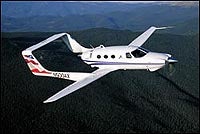 The natural assumption is that two engines must be better than one in terms of safety and performance but reality often gets in the way of such broad notions. Sure, the cushion of an extra engine is comforting on an IFR flight over the mountains but keeping two props spinning comes at a premium, not only in cost, but in the extra skill necessary to manage and handle the aircraft. Putting the engines one in front of the other eliminates many of those concerns, as we discovered on a demonstration flight in the Adam A500 during EAA AirVenture last week. The A500 was designed by Burt Rutan for Adam as an everyman’s twin that combines the power and redundancy of a twin with the flying qualities of a single. In development for more than five years, the aircraft has a provisional type certificate that limits it to VFR operations below 18,000 feet. Testing continues toward the final type certificate but Adam officials no longer make predictions on how long that will take. For now, the A500 is a clear-weather, dawn-to-dusk airplane.
The natural assumption is that two engines must be better than one in terms of safety and performance but reality often gets in the way of such broad notions. Sure, the cushion of an extra engine is comforting on an IFR flight over the mountains but keeping two props spinning comes at a premium, not only in cost, but in the extra skill necessary to manage and handle the aircraft. Putting the engines one in front of the other eliminates many of those concerns, as we discovered on a demonstration flight in the Adam A500 during EAA AirVenture last week. The A500 was designed by Burt Rutan for Adam as an everyman’s twin that combines the power and redundancy of a twin with the flying qualities of a single. In development for more than five years, the aircraft has a provisional type certificate that limits it to VFR operations below 18,000 feet. Testing continues toward the final type certificate but Adam officials no longer make predictions on how long that will take. For now, the A500 is a clear-weather, dawn-to-dusk airplane.
The natural assumption is that two engines must be better than one in terms of safety and performance but reality often gets in the way of such broad notions. Sure, the cushion of an extra engine is comforting on an IFR flight over the mountains but keeping two props spinning comes at a premium, not only in cost, but in the extra skill necessary to manage and handle the aircraft. Putting the engines one in front of the other eliminates many of those concerns, as we discovered on a demonstration flight in the Adam A500 during EAA AirVenture last week. The A500 was designed by Burt Rutan for Adam as an everyman’s twin that combines the power and redundancy of a twin with the flying qualities of a single. In development for more than five years, the aircraft has a provisional type certificate that limits it to VFR operations below 18,000 feet. Testing continues toward the final type certificate but Adam officials no longer make predictions on how long that will take. For now, the A500 is a clear-weather, dawn-to-dusk airplane.


